#city health covid test
Text
The Value of the Healthcare Marketplace: Know Everything

Using the Healthcare Marketplace to find affordable health insurance can be a great experience. You'll have the opportunity to compare healthcare plans, learn about special enrollment periods, and see how income limits affect your health plan. Cityhealth is one of the best healthcare platforms.
Compare healthcare plans in the Marketplace
Using the marketplace to compare healthcare marketplace plans may save you thousands of dollars a year. Moreover, a few plans offer free or cheap prescription drugs. You can also find a broker to help you make your decision. For more details on which plans are available in your area, contact your state health insurance agency. Choosing the right plan is not an exact science. You also choose Cityhealth for your good health.
A well-rounded plan should offer the most comprehensive benefits and the lowest premium. Having a good grasp of what you are buying is essential to making the best decision. The Marketplace is run by both government and private companies. To find out who runs the health insurance market in your area, visit eHealth. A broker can help you decide between Medicare, Medicaid, or a private plan. You can also find all the medical care at Cityhealth at state level. out about tax credits to help lower your monthly premiums. In fact, there is a special enrollment period for New Mexicans to save money on health insurance. Cityheath healthcare is one of the gowing platforms in CA, USA, which serves for the betterment of the society.
Whether you are shopping for a family plan, looking to save money on prescription drugs, or looking to improve your health in general, the Marketplace can help you get the coverage you need. A few plans even offer free or cheap vision coverage. Moreover, you can get your questions answered by a certified application counselor. There are even websites that can help you compare healthcare marketplace and determine which one is right for you. This is particularly important if you are planning on having children. In fact, this is the best time to buy health insurance in the state. In the long run, it is worth it to spend the time educating yourself about your options. Getting health insurance may seem like a daunting task, but with the right plans and a little foresight, you may be on your way to better health in no time. The key is to do your research and comparison shop.
Some of the qualifying events are pregnancy, moving, marriage, or losing other health coverage. Others include losing minimum essential coverage or Medicaid denials. The SEP can be backdated to the date of the qualifying event. The coverage can be selected during the SEP, and it may take effect as early as the first month after the plan is selected. The SEP also provides a three-month extension to make changes to an individual's coverage.
Income limits
Those in the market for health insurance are probably aware of the various benefits and incentives provided by the Affordable Care Act, but did you know there are income limits to the Affordable Care Act? Luckily, there are many ways to minimize the cost of your health care coverage. Those with the highest incomes can receive subsidies to cover their insurance premiums, and those with moderate incomes can obtain coverage through Medicaid. These subsidies are based on a person's estimated income. The amount is determined by comparing the person's income to the federal poverty level (FPL).
The most expensive plan is not always the best choice for everyone. However, the cost of a benchmark plan that covers the same basic services varies widely from one state to another, making the quest for an affordable healthcare marketplace a bit more complicated. Cityhealth is pretty affordable for all of you, you can get yourself treated there.
As the Affordable Care Act continues to roll out, more and more people will be able to find affordable health plans. A good rule of thumb is to have no more than 12 percent of your income go toward healthcare marketplace expenses. This is not a difficult task, but it may not be as simple as it seems. The best way to ensure that you are not out of pocket in the coming years is to shop around. There are several websites available to help you compare insurance plans and prices. Using these sites, you can learn more about the various subsidies available to you.
Plan options
Whether you are looking for an affordable health insurance plan for yourself or for your family, you can choose from a variety of plan options in the Healthcare Marketplace. These plans are designed to meet your specific needs. In addition to allowing you to choose a health insurance plan that is affordable, these plans offer several benefits. Some plans may offer lower monthly premiums and lower out-of-pocket costs. In addition, you may qualify for government subsidies to help pay for your health care.
Depending on the plan you choose, you may have access to a variety of pre-deductible services. These include prescription drugs, primary care, and mental health and substance use outpatient office visits. In addition, some plans offer lower prices for providers in their network. However, you may have to pay more for services if you choose to see providers outside the network. Some plans may also limit the types of providers you can see. If you want to get treatment of Covid-19 in CA, then Cityhealth is the best one, you can go for.
Some plans also offer a choice of different metal levels. Metal levels are based on how Care Source shares the cost of health care. These levels range from bronze to gold. If you're interested in Care Source's marketplace plan, you'll need to understand how the plan works to get the best plan for you. Depending on your situation, you may qualify for a government subsidy to help pay for your Care Source plan.
Source Link
0 notes
Text
Great Big Good Omens Graphic Novel Update
AKA A Visit From Bildad the Shuhite.
The past year or so has been one long visit from this guy, whereupon he smiteth my goats and burneth my crops, woe unto the woeful cartoonist.
Gaze upon the horror of Bildad the Shuhite.

You kind of have to be a Good Omens fan to get this joke, but trust me, it's hilarious.
Anyway, as a long time Good Omens novel fan, you may imagine how thrilled I was to get picked to adapt the graphic novel.
Go me!
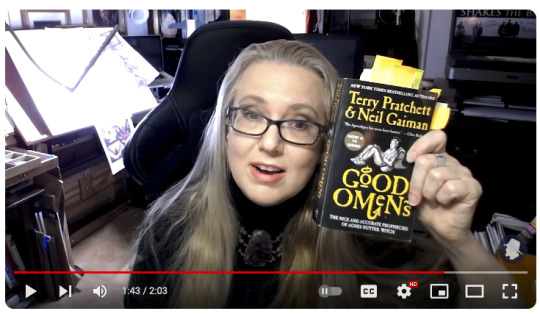
This is quite a task, I have to say, especially since I was originally going to just draw (and color) it, but I ended up writing the adaptation as well. Tricky to fit a 400 page novel into a 160-ish page graphic novel, especially when so much of the humor is dependent on the language, and not necessarily on the visuals.
Not complainin', just sayin'.
Anyway, I started out the gate like a herd of turtles, because right away I got COVID which knocked me on my butt.
And COVID brain fog? That's a thing. I already struggle with brain fog due to autoimmune disease, and COVID made it worse.
Not complainin' just sayin'.
This set a few of the assignments on my plate back, which pushed starting Good Omens back.
But hey, big fat lead time! No worries!
Then my computer crawled toward the grave.
My trusty MAC Pro Tower was nearly 15 years old when its sturdy heart ground to a near-halt with daily crashes. I finally got around to doing some diagnostics; some of its little brain actions were at 5% functionality. I had no reliable backups.
There are so many issues with getting a new computer when you haven't had a new computer or peripherals in nearly fifteen years and all of your software, including your Photoshop program is fifteen years old.
At the time, I was still on rural internet...which means dial-up speed.

Whatever you have for internet in the city, roll that clock back to about 2001.
That's what I had. I not only had to replace almost all of my hardware but I had to load and update all programs at dial-up speed.
Welcome to my gigabyte hell.
The entire process of replacing the equipment and programs took weeks and then I had to relearn all the software.
All of this was super expensive in terms of money and time cost.
But I was not daunted! Nosirree!
I still had a huge lead time! I can do anything! I have an iron will!
And boy, howdy, I was going to need it.
At about the same time, a big fatcat quadrillionaire client who had hired me years ago to develop a big, major transmedia project for which I was paid almost entirely in stock, went bankrupt leaving everyone holding the bag, and taking a huge chunk of my future retirement fund with it.
I wrote a very snarky almost hilarious Patreon post about it, but am not entirely in a position to speak freely because I don't want to get sued. Even though I had to go to court over it, (and I had to do that over Zoom at dial-up speed,) I'm pretty sure I'll never get anything out of this drama, and neither will anyone else involved, except millionaire dude and his buddies who all walked away with huge multi-million dollar bonuses weeks before they declared bankruptcy, all the while claiming they would not declare bankruptcy.
Even the accountant got $250,000 a month to shut down the business, while creators got nothing.
That in itself was enough drama for the year, but we were only at February by that point, and with all those months left, 2023 had a lot more to throw at me.
Fresh from my return from my Society of Illustrators show, and a lovely time at MOCCA, it was time to face practical medical issues, health updates, screening, and the like. I did my adult duty and then went back to work hoping for no news, but still had a weird feeling there would be news.
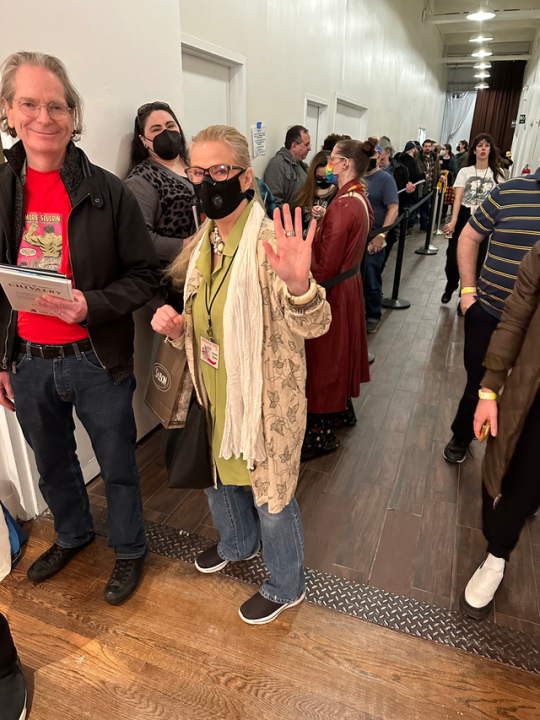
I know everyone says that, but I mean it. I had a bad feeling.
Then there was news.
I was called back for tests and more tests. This took weeks. The ubiquitous biopsy looked, even to me staring at the screen in real time, like bad news.
It also hurt like a mofo after the anesthesia wore off. I wasn't expecting that.
Then I got the official bad news.
Cancer which runs in my family finally got me. Frankly, I was surprised I didn't get it sooner.
Stage 0, and treatment would likely be fast and complication-free. Face the peril, get it over with, and get back to work.
I requested surgery months in the future so I could finish Good Omens first, but my doc convinced me the risk of waiting was too great. Get it done now.
"You're really healthy," my doc said. Despite an auto-immune issue which plagues me, I am way healthier than the average schmoe of late middle age. She informed me I would not even need any chemo or radiation if I took care of this now.
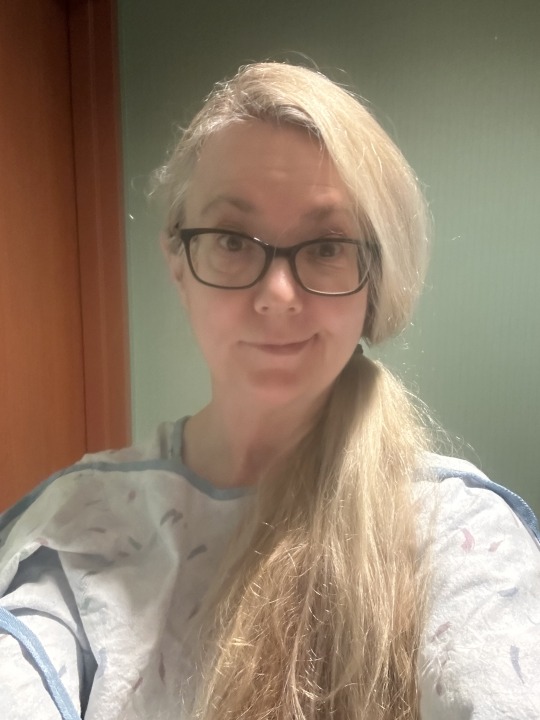
So I canceled my appearance at San Diego Comic Con. I did not inform the Good Omens team of my issues right away, thinking this would not interfere with my work schedule, but I did contact my agent to inform her of the issue. I also contacted a lawyer to rewrite my will and make sure the team had access to my digital files in case there were complications.
Then I got back to work, and hoped for the best.
Eff this guy.

Before I could even plant my carcass on the surgery table, I got a massive case of ocular shingles.
I didn't even know there was such a thing.
There I was, minding my own business. I go to bed one night with a scratchy eye, and by 4 PM the next day, I was in the emergency room being told if I didn't get immediate specialist treatment, I was in big trouble.
I got transferred to another hospital and got all the scary details, with the extra horrid news that I could not possibly have cancer surgery until I was free of shingles, and if I did not follow a rather brutal treatment procedure - which meant super-painful eye drops every half hour, twenty-four hours a day and daily hospital treatment - I could lose the eye entirely, or be blinded, or best case scenario, get permanent eye damage.
What was even funnier (yeah, hilarity) is the drops are so toxic if you don't use the medication just right, you can go blind anyway.
Hi Ho.
Ulcer is on the right. That big green blob.
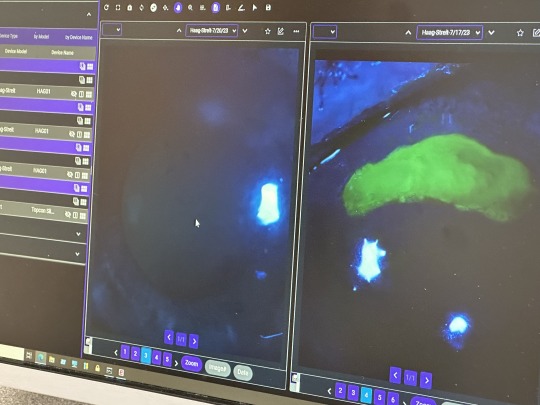
I had just finished telling my cancer surgeon I did not even really care about getting cancer, was happy it was just stage zero, had no issues with scarring, wanted no reconstruction, all I cared about was my work.
Just cut it out and get me back to work.
And now I wondered if I was going to lose my ability to work anyway.
Shingles often accompanies cancer because of the stress on the immune system, and yeah, it's not pretty. This is me looking like all heck after I started to get better.
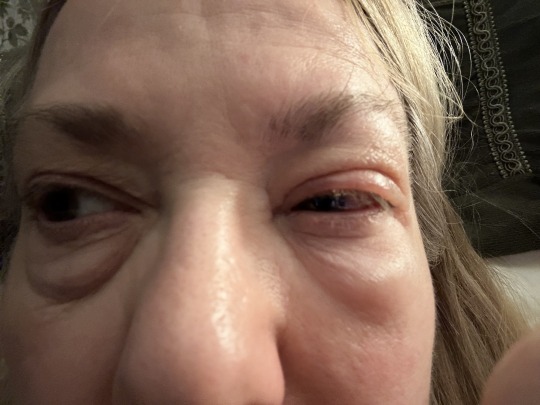
The first couple of weeks were pretty demoralizing as I expected a straight trajectory to wellness. But it was up and down all the way.
Some days I could not see out of either eye at all. The swelling was so bad that I had to reach around to my good eye to prop the lid open. Light sensitivity made seeing out of either eye almost impossible. Outdoors, even with sunglasses, I had to be led around by the hand.
I had an amazing doctor. I meticulously followed his instructions, and I think he was surprised I did. The treatment is really difficult, and if you don't do it just right no matter how painful it gets, you will be sorry.
To my amazement, after about a month, my doctor informed me I had no vision loss in the eye at all. "This never happens," he said.
I'd spent a couple of weeks there trying to learn to draw in the near-dark with one eye, and in the end, I got all my sight back.
I could no longer wear contact lenses (I don't really wear them anyway, unless I'm going to the movies,) would need hard core sun protection for awhile, and the neuralgia and sun sensitivity were likely to linger. But I could get back to work.
I have never been more grateful in my life.
Neuralgia sucks, by the way, I'm still dealing with it months later.
Anyway, I decided to finally go ahead and tell the Good Omens team what was going on, especially since this was all happening around the time the Kickstarter was gearing up.
Now that I was sure I'd passed the eye peril, and my surgery for Stage 0 was going to be no big deal, I figured all was a go. I was still pretty uncomfortable and weak, and my ideal deadline was blown, but with the book not coming out for more than a year, all would be OK. I quit a bunch of jobs I had lined up to start after Good Omens, since the project was going to run far longer than I'd planned.
Everybody on the team was super-nice, and I was pretty optimistic at this time. But work was going pretty slow during, as you may imagine.
But again...lots of lead time still left, go me.
Then I finally got my surgery.
Which was not as happy an experience as I had been hoping for.
My family said the doc came out of the operating room looking like she'd been pulled backwards through a pipe, She informed them the tumor which looked tiny on the scan was "...huge and her insides are a mess."
Which was super not fun news.
Eff this guy.

The tumor was hiding behind some dense tissue and cysts. After more tests, it was determined I'd need another surgery and was going to have to get further treatments after all.
The biopsy had been really painful, but the discomfort was gone after about a week, so no biggee. The second surgery was, weirdly, not as painful as the biopsy, but the fatigue was big time.
By then, the Good Omens Kickstarter had about run its course, and the record-breaker was both gratifying and a source of immense social pressure.
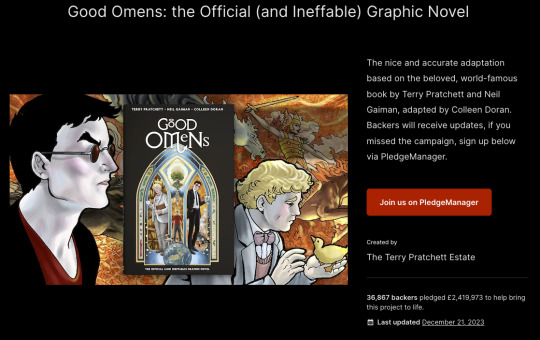
I'd already turned most of my social media over to an assistant, and I'm glad I did.
But the next surgery was what really kicked me on my keister.

All in all, they took out an area the size of a baseball. It was hard to move and wiped me out for weeks and weeks. I could not take care of myself. I'd begun losing hair by this time anyway, and finally just lopped it off since it was too heavy for me to care for myself. The cut hides the bald spots pretty well.
After about a month, I got the go-ahead to travel to my show at the San Diego Comic Con Museum (which is running until the first week of April, BTW). I was very happy I had enough energy to do it. But as soon as I got back, I had to return to treatment.
Since I live way out in the country, going into the city to various hospitals and pharmacies was a real challenge. I made more than 100 trips last year, and a drive to the compounding pharmacy which produced the specialist eye medicine I could not get anywhere else was six hours alone.
Naturally, I wasn't getting anything done during this time.
But at least my main hospital is super swank.


The oncology treatment went smoothly, until it didn't. The feels don't hit you until the end. By then I was flattened.
So flattened that I was too weak to control myself, fell over, and smashed my face into some equipment.

Nearly tore off my damn nostril.
Eff this guy.

Anyway, it was a bad year.
Here's what went right.
I have a good health insurance policy. The final tally on my health care costs ended up being about $150,000. I paid about 18% of that, including insurance. I had a high deductible and some experimental medicine insurance didn't cover. I had savings, enough to cover the months I wasn't working, and my Patreon is also very supportive. So you didn't see me running a Gofundme or anything.
Thanks to everyone who ever bought one of my books.
No, none of that money was Good Omens Kickstarter money. I won't get most of my pay on that for months, which is just as well because it kept my taxes lower last year when I needed a break.
So, yay.
My nose is nearly healed. I opted out of plastic surgery, and it just sealed up by itself. I'll never be ready for my closeup, but who the hell cares.
I got to ring the bell.
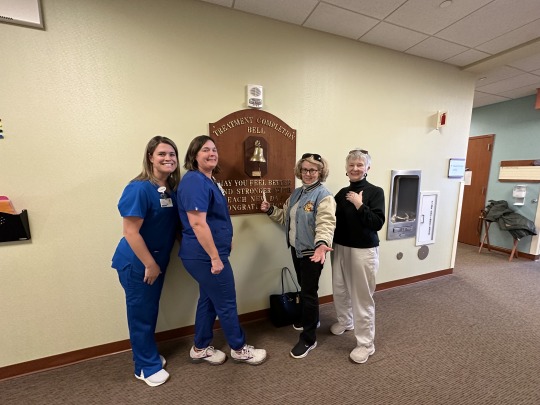
I had a very, VERY hard time getting back to work, especially with regard to focus and concentration. My work hours dropped by over 2/3. I was so fractured and weak, time kept slipping away while I sat in the studio like a zombie. Most of the last six months were a wash.
I assumed focus issues were due (in part) to stress, so sought counseling. This seemed like a good idea at first, but when the counselor asked me to detail my issues with anxiety, I spent two weeks doing just that and getting way more anxious, which was not helpful.
After that I went EFF THIS NOISE, I want practical tools, not touchy feelies (no judgment on people who need touchy-feelies, I need a pragmatic solution and I need it now,) so tried using the body doubling focus group technique for concentration and deep work.
Within two weeks, I returned to normal work hours.
I got rural broadband, jumping me from dial up speed to 1 GB per second.
It's a miracle.

Massive doses of Vitamin D3 and K2. Yay.
The new computer works great.
The Kickstarter did so well, we got to expand the graphic novel to 200 pages. Double yay.
I'm running late, but everyone on the Good Omens team is super supportive. I don't know if I am going to make the book late or not, but if I do, well, it surely wasn't on purpose, and it won't be super late anyway. I still have months of lead time left.
I used to be something of a social media addict, but now I hardly ever even look at it, haven't been directly on some sites in over a year, and no longer miss it. It used to seem important and now doesn't.
More time for real life.
While I think the last year aged me about twenty years, I actually like me better with short hair. I'm keeping it.

OK. Rough year.
Not complainin', just sayin'.
Back to work on The Book.

And only a day left to vote for Good Omens, Neil Gaiman, and Sandman in the Comicscene Awards. Thanks.
2K notes
·
View notes
Text
In photos of 2023’s World Economic Forum- or Davos as it is commonly called, after the Swiss resort town where it annually occurs- you might not notice the HEPA filters. They’re in the background, unobtrusive and unremarked upon, quietly cleansing the air of viruses and bacteria. You wouldn’t know- not unless you asked- that every attendee was PCR tested before entering the forum, or that in the case of a positive test, access was automatically, electronically, revoked. And if you happened to get a glimpse of the strange blue lights overhead, you could reasonably assume that their glow was simply a modern aesthetic choice, not the calming buzz of cutting edge Far UVC technology- demonstrated to kill microbes in the air.
It’s hard to square this information with the public narrative about COVID, isn’t it? President Biden has called the pandemic “over”. The New York Times recently claimed that “the risk of Covid is similar to that of the flu” in an article about “hold outs” that are annoyingly refusing to accept continual reinfection as their “new normal”. Yet, this week the richest people in the world are taking common sense, easy- but strict- precautions to ensure they don’t catch Covid-19 at Davos.
These common sense, easy precautions include high-quality ventiliation, use of Far UVC-lighting technology, and PCR testing. You’ll also see some masks at Davos, but generally, the testing + air filtration protocol seems to be effective at preventing the kind of super-spreader events most of us are now accustomed to attending.
It seems unlikely to me that a New York Times reporter will follow the super-rich around like David Attenborough on safari, the way one of their employees did when they profiled middle-class maskers last month. I doubt they will write “family members and friends can get a little exasperated by the hyper-concern” about the assembled Prime Ministers, Presidents and CEOs in Switzerland. After all, these are important people. The kind of people who merit high-quality ventilation. The kind of people who deserve accurate tests.
Why is the media so hellbent on portraying simple, scientifically proven measures like high-quality ventilation as ridiculous and unnecessary as hundreds of people continue to die daily here in the US?
Why is the public accepting a “new normal” where we are expected to get infected over and over and over again, at work events with zero precautions, on airplanes with no masks, and at social dinners trying to approximate our 2019 normal?
We deserve better. We deserve to be #DavosSafe as the hashtag going around on twitter puts it. Your children deserve to be treated with the care that world leaders are treating each other. Your family deserves to be protected from the disease which is still- unlike the flu- the third leading cause of death in the US. We don’t deserve to be shoved back into poorly ventilated workplaces while our politicians and press assure us that only crazy people would demand to breathe clean air.
Clean water and clean food are rights we fought for; we have regulatory bodies that ensure we aren’t exposed to pathogens via our water supply nor our food. In 1854, John Snow famously conducted his Broad Street Pump study in London and demonstrated that cholera was water-bourne; however, it took decades for our public policy to catch up with our scientific knowledge.
A public health case study published by the NBCI describes the years that followed:
The first use of chlorine as a disinfectant for water facilities was in 1897 in England. The first use of this method for municipal water facilities in the United States was in Jersey City, New Jersey, and Chicago, Illinois, in 1915. Other cities followed and the use of chlorination as standard treatment for water disinfection rapidly grew. During the 20th century, death rates from waterborne diseases decreased significantly, and although other additional factors contributed to the general improvements in health (such as sanitation, improved quality of life, and nutrition), the improvement of water quality was, without doubt, a major reason.
Forty-three years passed from the initial demonstration that pathogens were being spread via water, and public action and regulation to halt disease.
Can you imagine, in the 1890s, being somebody who argued against cleaning the water?
Can you imagine, in those years of plentiful cholera, calling the people who demanded shit-free water “hold outs”?
One thing COVID realists are accused of is being “doomsayers” and “fearmongers,” so let me share a dose of optimism about the future with you. When we choose- whenever we choose- to get COVID under control, there’s an exciting new world awaiting us. One, not only without constant COVID reinfection, but where our kids can grow up free of colds, flus, RSV, and many other common bugs. And no, contrary to what you may have heard, staying healthy (shockingly enough) is not bad for children!
Once we choose to institute ventilation standards and introduce new technologies like Far UVC lighting- and embrace masking as an easy, kind, and useful tool to control outbreaks- we can bring every nasty airborne pathogen under control the way we did cholera. We didn’t have the science before; now we do. (I mean that quite literally; I can’t recommend enough the linked Wired article cataloguing the long journey to establishing that Covid is, indeed, airborne).
We face a stark choice; down one road, the one with zero infrastructure upgrades, no air quality regulations, and Covid safety only for those who can afford it, you and your family will get Covid this year. You will get Covid next year. You will continue to get Covid over and over and over again, as the health problems - like cardiac damage, viral persistance, and immune system dysfunction- continue to build up. (The billionaires, of course, will not).
Down the other road, we quite simply treat ourselves the way Davos would. We engage with what the science is telling us and we build a safer, better world for our kids. We embrace the lessons this pandemic is teaching us, and let go of things we now know are harming people. We stop clinging desperately to the idea that 2019 will come back if we just get the virus one more time, and we come together to achieve what we’ve been told is impossible: elimination.
The economic elite thrive on our divisiveness and blame casting. They don’t mind that we’re calling each other names, engaging in racial stereotyping, or leaving disabled people to die, so long as we keep their machine running. But we can choose to stop throwing blame at each other, and direct it where it belongs: at the powerful people who’ve left us to suffer, at the politicians who are whipping people into a frenzy over masks instead of over our millions of dead, at the talking heads on TV that work so hard to convince us: you want to get sick. It’s better than being a *weirdo* or a *hold out*.
We needn’t wait 43 years to redirect our energies. France and Belgium have already introduced new air quality standards, and DIY projects to build Corsi-Rosenthal boxes for schools and healthcare settings have popped up around the country. We have the science, we have the technology. All we need now is the political will and the solidarity to truly end the pandemic- the kind of solidarity the super rich always show with one another.
The billionaires at Davos don’t accept continual Covid reinfection. They demand better. It’s time we demand better too.
8K notes
·
View notes
Text
every trip or event I've heard of happening in the past like. month. has resulted in people i know or know of getting covid. and im still recovering from having it myself from a trip i didn't even go on partially out of safety concerns so it's like. even though im PERSONALLY probably the safest I'll be from getting sick, i am. very :/ about the idea of going to pride this weekend
#absolutely no one in this goddamn city masks anymore#not restaurant workers not grocery store workers the pharmacy workers aren't even serious about it#and the more I think about it the more positive i am that a bunch of people are gonna get covid after pride this weekend#actually i've just had a look through the whole website and there's no fucking mention of covid so yeah absolutely not#last year in september i went and was in the minority wearing a mask and shit has only gotten worse since#but at least they fucking required vaccine card or recent negative official test#this year? I can't find ANY policies at all for this huge crowded event#when covid rates are going up and up#no one fucking CARES anymore#i've been coughing for a week past my other symptoms and i THINK it's getting better but it's frankly hard to tell#and i THINK it being harder to breathe whenever I've been out is just my bra being too small being exacerbated by it#bc it feels like when I wear a binder for a couple hours#but it's! fucking hard to tell! and even if i do fully recover soon! it's fucking sucked!#and going back to the office today where im one of two people who wear a mask consistently is just! a fuckin slap in the face!#hate it here.#hate knowing that like everywhere else in the country is probably just as bad now.#jess pretends to have a life#sick and fucking tired of people doing things how many people have to die before we get back to giving a shit#saw stuff about new theories that every single person who gets any form will have permanent health impacts they just may be too mild to see#and also it's shown that after the initial period of I guess temporary immunity from getting it again you're MORE likely to get covid#the more times you've had it#and it's like great thanks i love to have my family screw over my health in even more ways than they did with genetics#im. tired.#and i hate coughing
1 note
·
View note
Note
Any advice on finding and going to kink events?? I’d love to go out to one if I get the courage hehe but I’m not sure where to start or what the etiquette tends to be or whatever
Yes!!! I was more confident about giving advice about this pre-covid. So first and foremost, be safe, your health and the health of others is more important than social gatherings. I have my own comfort levels (I haven’t been to a bar or club since pre covid and don’t see myself doing that anytime soon, for example, and anywhere I’m going to be indoors around people who haven’t tested I wear a mask, typically an N95) and so like… that has put a bit of a damper on my kink social life. What was I talking about.
OKAY. Right. Kink events. Honestly, most of the advice I have to give isn’t, you know, revolutionary or genius. My strategies have been “make friends in the city I move to and ask them where is cool” and “look online.” I only recently started using fetlife to browse for events, it seems alright, but I haven’t found anything there I hadn’t already heard about through word of mouth. Alternatively, you can search-engine-of-your-choice “BDSM dungeon [your city]” and look for an events page.
With pride coming up, you’re likely to see vendors and groups out and about. Go up to them and ask them questions! People who are advertising what their thing is are going to be thrilled to talk to you. A lot of clubs and dungeons have socials and munches (vanilla events that take place offsite where you can just get to know people) and the great thing about BDSM people is that they are educated on consent and negotiation—the etiquette of an event like that will be clearly laid out.
Listen though, for real? If you want to meet kinksters and you don’t know how, fetlife seems sketchy and dating apps are annoying and all your tumblr mutuals live on the other side of the globe and pride events aren’t really your thing? Go to your local game store and join a dnd group. I am being one thousand percent serious. The venn diagram of tabletop nerds and people who are into kink is very nearly a circle. The difference with that, of course, is that it’s impolite to waltz right in and ask right out of the gate “who here is into sexual domination?????” but if you also enjoy geeky hobbies and will have fun even if you don’t happen to stumble upon a fellow pervert… then I recommend giving it a try. My closest friends in kink I initially met through tabletop.
This is getting long BUT you asked about general etiquette and what to expect so I’ll give you a quick rundown. In my experience, there are three types of kink events: formal play parties, casual play parties, and munches. A formal play party would take place at a dungeon or club (sometimes private residences but that’s less common), somewhere with designated hard points, gear you can use, and dungeon monitors making sure everything runs smoothly. Typically, anything particularly dangerous (blood play, breathplay, etc) will be completely disallowed. You can watch other people doing scenes, or approach people and ask if they’d be interested in doing a scene with you. Casual play parties are just sex parties at somebody’s house, typically much smaller, and something you’d only be invited to if you knew the person who owned the place or a friend of theirs. You’d typically be expected to bring your own gear. And lastly, munches are vanilla events out in public where no play takes place, you just have drinks and food and get to know people!
I hope this is anything close to the answer you were looking for 🖤
111 notes
·
View notes
Note
I'm curious if you've come across any examples of what you would consider effective communication or collective organizing around Covid? I know of a few groups who I think are doing good work to get people access to masks and rapid tests, making connections to broader issues such as lack of sick leave, barriers to healthcare etc, but they're also relying on things like questionable wastewater data extrapolation to make their points. I don't really know what to do about the latter issue, since we've just had access to all data taken away from us by the government. (I know it's not an effective tool for collective action, but tbh I also struggle with the idea that all alarmism is bad, because I am high risk and I am scared!)
well 1st of all to be clear, i think wastewater data are valuable and i do look at them. what i don't do is make wildly overconfident guesses from those data about exactly how many people are infected, how many sick people are standing in any given room, how many people will eventually qualify for a long covid dx, etc. i think wastewater data are a rough proxy but still an important one, and generally more useful at the local level (where they can be cross-referenced with factors like vaccine uptake, circulating variants, and municipal public health policy) than at national or regional levels (where the necessary amount of aggregation makes it difficult to tease out much useful information about any one town or city).
2nd, i don't know what country you live in but i do look in on CDC's covid dashboard, which includes data on hospitalisations, emergency department visits, deaths, vaccine uptake, test positivity rates, &c. if this is applicable to you i strongly encourage always reading the footnotes as these statistics vary in accuracy (in particular, test positivity rate is very unreliable at this point). i consider a lot of these numbers useful primarily as indicators of comparative risk: eg, i assume hospitalisation numbers have been inaccurate lowballs for the entirety of the pandemic; however, it is still useful imo to see whether that number is trending in a particular direction, and how it compares over time. again, local results are sometimes more helpful as well. i also glance in on the census bureau's household pulse survey results, which come out numerous times throughout the year and include questions about duration of covid symptoms, ability to function, and vaccine uptake. these numbers skew in the opposite direction to many of CDC's, because the phrasing of the covid questions is intended to be broad, and does not attempt to distinguish between the sort of long covid that entails a 6 or 12 month recovery period, vs the sort of long covid that turns out to be me/cfs or other chronic long-term post-viral complications. again, i still think these numbers are useful for viewing trends over time; no data will ever be completely 100% without flaw, and i'm not holding out for that. what does frustrate me, though, is people (with any and all ideological axes to grind!) interpreting any of these numbers as though they are in fact perfect flawless representations of reality, with no further caveats or critical analysis needed. that's what i'm pushing back on, whether it comes from the "pulse survey says long covid prevalence is decreasing, so fuck it!" crowd or the "biobot says last week was a micro-surge so we're all going to die!" crowd.
as far as local orgs or groups doing actual action, like distributing masks or vaccine clinics, i don't put so much stock in what they say on instagram or whatever because frankly i think it matters very little. the masks and vaccines and air filters and so forth are useful in themselves; that work is valuable. if someone's positioning themselves primarily as a communicator then yes, i'm going to scrutinise their communication methods more. if it's an action org i'm honestly less concerned, unless there is egregiously unreliable information being propagated or they're communicating in the sort of stigmatising manner that many peak Posters have adopted (people who got sick are stupid / immoral / deserve it, etc).
i'd also just like to make it clear that like... i live with someone who is at high risk, i accordingly treat my own covid precautions as though i am also at high risk, and i wouldn't want covid regardless... like, please understand that when i talk about this i'm not coming at it from a perspective of someone who's unaware of the need for caution! my concern is, again, that caution and risk discussion are not synonymous with "making frightened guesses and asserting them with 100% confidence" or "selectively attributing truth to data because they agree with me, regardless of the actual methodology and any problems therein". i understand that when people are behaving recklessly and being encouraged to do so by state and medical authorities, it is tempting to look at that situation and think that communicating the seriousness of the virus is worth risking a little bit of inaccuracy if it protects people. however, i do not think that strategy actually pays off in the long or short term as far as changing people's behaviour (if it did, wouldn't it have by now?) and i think it is playing with fire to encourage this manner of interpreting and disseminating scientific information as though it is a kind of ideological buffet requiring no further verification or investigation beyond a cherry-picked deference to the stated objectivity and ideals of The Scientific Method.
26 notes
·
View notes
Text
The Best News of Last Week #049
1. First 100,000 KG Removed From the Great Pacific Garbage Patch

The Ocean Cleanup has been working on ridding the world of the GPGP since 2013. Its founder and CEO, Boyan Slat, said the company’s current cleanup platform, System 002, had collected 101,353kg of plastic since being deployed in August 2021. The cleanups swept a 3,000 square kilometer area of the Pacific, roughly equivalent to the size of Rhode Island or Luxembourg.
2. There are 40% more tigers in the world than previously estimated

It’s the Year of the Tiger, and a new population assessment offers some hope for the endangered species.
An estimated 3,726 to 5,578 tigers currently live in the wild worldwide — up 40% from 2015, according to a new tiger assessment from the International Union for Conservation of Nature (IUCN). Tigers are still considered endangered and remain on the IUCN’s Red List, which assesses endangered species.
3. Fourth patient seemingly cured of HIV
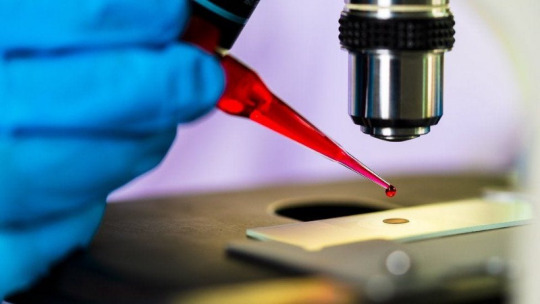
A man who has lived with HIV since the 1980s seems to have been cured in only the fourth such case, say doctors. He was given a bone marrow transplant to treat blood cancer leukaemia from a donor who was naturally resistant to the virus.
The 66-year-old, has stopped taking HIV medication. He said he was “beyond grateful” the virus could no longer be found in his body. The man is known as the “City of Hope” patient after the hospital where he was treated in Duarte, California.
4. Pennsylvania nurses receiving student debt cancellation

Nurses across Pennsylvania will begin receiving notifications next week about whether they are eligible for a share of the $55 million the state is making available to lower or erase their student loan debt.
The money for Pa. Student Loan Relief for Nurses Program comes out of state’s share of federal American Rescue Plan funds. This one-time offer will relieve selected state-licensed nurses who cared for patients during the COVID-19 pandemic at a Pennsylvania health care facility of up to $7,500 of student loan debt.
5. This beautiful blue parrot has returned to the wild 2 years after being declared extinct

After teetering on the edge of extinction, the beautiful Spix’s macaw has made its return to the wild, over two decades after the last bird was seen in nature. Eight of the bright blue parrots have been released into a protected nature reserve in Brazil.
“They’re doing absolutely wonderful. So far there is 100 per cent survival. The birds are all staying together as a group… They’re staying in around the release area. And they’re also beginning to forage on natural occurring foods,” biologist Tom White told The Current guest host Duncan McCue.
6. New research shows that signs of Alzheimer’s can be found in blood 17 years before symptoms begin.
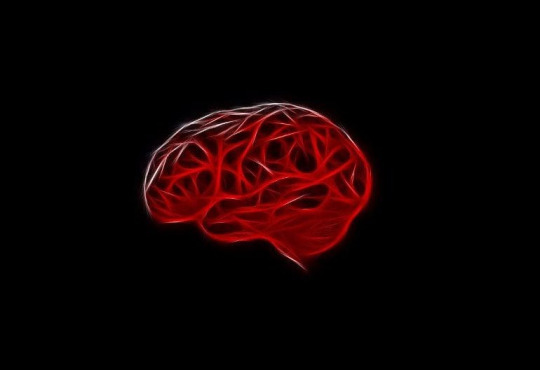
A newly developed immuno-infrared sensor allowed researchers to discover biomarkers for Alzheimer’s disease in blood samples 17 years before clinical symptoms appeared.
The goal is to determine the risk of developing Alzheimer’s dementia at a later stage with a simple blood test even before the toxic plaques can form in the brain, in order to ensure that a therapy can be initiated in time.
7. Drone lifeguard saves boy, 14, from drowning in sea in Valencia in Spain
youtube
A pioneering drone lifeguard has saved a 14-year-old boy from drowning in the sea in Valencia in Spain.
The drone lifeguard service, which has been rolled out across Spanish beaches, dropped a life vest into the sea this month that was able to keep the teenager afloat just as he started to sink, its operators have said. The vest kept the boy afloat until a physical lifeguard team arrived moments later.
...
That’s it for this week. This newsletter will always be free. If you liked this post you can support me with a small kofi donation:
Buy me a coffee ❤️
574 notes
·
View notes
Text
Hey its a Lil late in the month but this disability pride month I wanna talk about long covid. I also have chronic pain and all sorts of worms in my brain but I've been dealing with that forever. So we're talking about the new stuff. Putting a readmore because I'm talking about what my experience being sick with covid was like and it's probably unpleasant to read.
It's December of 2022 and I work retail while I'm home from school for winter break. I mask up every time I leave the house, including for work. My parents don't. My father talks about covid not being a big deal. He caught it last year and it was a mild cold for him. He says "i ate lunch with someone who had covid last week and im fine!" My mother catches covid a week after that conversation. I test and am seemingly fine despite symptoms of a cold, and then three days later (one of those days was a full 8hr shift at work where I was worn ragged because it's almost christmas. I also got heat exhaustion because the AC was busted and I live in TX.) I feel the worst I have felt in ages. My mom insists that my dad takes me to get tested for the flu, and I schedule a covid test while I'm at it. My covid test comes back positive.
For the next week I am bedbound, only able to sit up enough to try to eat something and only able to stand up long enough to get myself to and from the bathroom. I sleep through the days when I can get the dayquil down, and cough through the nights when I can't get the nyquil down. I hallucinate when im tired. One of those nights I swear I talk to god. My brain is fogged and it hurts to breathe. I am worried I will need to be hospitalized because I can't seem to keep any water in my system. It's a miracle that I can write instructions for my father to cook ramen for me. I can only drink the broth. One morning I try to take dayquil to soothe my throat and I vomit. My stomach is empty and I stand over the sink wretching.
It feels like a miracle when I recover. Christmas day my symptoms mostly clear up and I'm able to sit up long enough to use my computer, something I was unable to do for the past week. I test negative, my second best Christmas present that year. The first is the Elden Ring soundtrack on vinyl. I am elated that I made it put the other end.
A week later my friend comes from a few cities away to visit for a few days. We go shopping one afternoon, spend a few hours standing around at the local game store looking at dice and miniature plastic dragons. We get home at 6pm. I collapse into bed and wake up 3 hours later. I talk to my doctor about it in January, she says it should go away over time. Six months maximum.
I spend my spring semester exhausted. I start using a cane to make sure I can walk across campus. I'm thankful that many of my friends are also disabled because they understand when I need to ask people to slow down, or bail because of my fatigue. Many of the abled people in my life do not understand. One day I go out to a museum, a thing I am excited to do. When I get home at 4pm I make myself popcorn, then collapse into bed. I can't walk to the sink without my cane, I can barely get out of bed. This is what I have to adjust to.
Six months pass. The fatigue is not gone. I am home for summer break, and I try talking to my parents about my fatigue. They don't understand. I talk to my doctor. She is convinced it's depression symptoms. My mental health is largely the best it's been in years- I've been in treatment for months now and it is helping.
It's been about seven months now. I am not receiving treatment, nor will my doctor acknowledge that I have long covid. She has relented into testing for physical things. I got a CT scan, and have a sleep study scheduled for when I get back from visiting family in August. Depending on what these turn up and how my doctor reacts I am preparing to find a new doctor. I am not excited about this, because I like my doctor. But if she refuses to acknowledge that what has happened to me is likely covid and therefore will not treat me I will find someone else.
I don't really have a moral here beyond please mask up, get vaccinated, etc. Even if covid doesn't fuck you up it might fuck up someone you pass it to. Or even worse, it can kill the immunocompromised people around you. Please have compassion for the people around you. My father, who is a loving and caring man, brought this illness home to me. It wasn't out of malice, but it still has affected my life for probably the rest of my life.
36 notes
·
View notes
Text
Doctors often tell patients, often chronically ill patients to stay off the social media that talks about their illnesses and to not look stuff up, and i can understand why this may be problematic but they also aren’t taking into consideration the positives and good things that can also occur from this.
POTS and other chronic illnesses are having a higher social media presence, and because of this it’s created quite a big stigma surrounding it, and people often think that these illnesses are just becoming a trend, but they don’t understand how helpful the representation is for so many people.
I do often see people in the comment section of these videos who will have one or two traits and immediately panic thinking they have these things and i can understand how that part isn’t great, but in some cases it actually is these posts online that help people get diagnoses and learn more about themselves.
I would not have been diagnosed with POTS and getting treatment if it weren’t for social media, and my doctors don’t know much about POTS so most of the tips and advice and treatment methods that i’ve found have been from social media, and i would not be where i am without it.
I struggled with dysautonomia for my entire life, and it had been established by my one doctor who actually knew about these conditions but he retired and the new doctors i was switched too don’t know much about my health conditions, so getting diagnoses and treatment has been a very slow process.
My dysautonomia is believed to have turned into POTS in early 2021 when i was 14 after i got covid, and for over a year i was struggling with debilitating symptoms and had no idea why. I was just starting high school, and i was getting sicker and sicker and it was causing quite the divide socially.
I had been diagnosed with fibromyalgia, and because of it i had already been limited in my physical activity, so i was just told that my POTS symptoms were because i was out of shape.
I tried to push myself to fix this, which only ended up making me feel worse. Sometime along the road of me trying to get more active, i got a fitbit.
I started using my watch to monitor my steps and sleep, and i noticed that my heart rate would shoot up to the 150s-170s when i was simply standing still, so i sat down, and my heart rate immediately dropped to the low 100s.
I thought that this may be a glitch with my watch, but was still concerned as i was aware that my heart rate should not get that high from just standing still, so i started googling. As a result of my search, the name Postural Orthostatic Tachycardia Syndrome came up. I did some reading, and noticed that a lot of the signs were pointing to me, especially with the already established dysautonomia.
I had already dealt with a lot of doctors telling me that i was just paranoid and a hypochondriac, and i knew that watches sometimes glitched or didn’t work correctly, so i went to my pharmacy and got a pulse ox, and did the same standing test and it did the exact same thing as my watch.
I took pictures of my heart rate and started recording it on the charts that my watch had, and brought it to my next doctors appointment, explained my symptoms and then mentioned that i had heard of the condition POTS, and that it seemed pretty similar to what i was going through. My doctor had my do a short standing test in the office, and i had a 70bpm increase in my heart rate.
My doctor agreed that it definitely looked like POTS and she said that i met the criteria for a diagnosis, but she said she didn’t know very much about the condition and had only briefly heard about it, so she referred me to a cardiologist in another city as that was the closest specialist to me, but they denied the referral and said that they weren’t taking patients with POTS, and they gave her a information sheet and gave her some tests to do to rule out anything else.
The tests came back, and again it all pointed to POTS, but my doctor was scarcely familiar with the condition, and wasn’t comfortable giving me an official diagnosis, so she gave me an informal diagnosis. When it came to treatments, she also wasn’t familiar with anything besides telling me to drink more water, exercise, and increase my sodium intake, and the only medication she was familiar to treat it with was propranolol, so she prescribed that, but it unfortunately didn’t help much, so i wasn’t left with much help or advice.
The things my doctor recommended weren’t enough, and because i didn’t have an official diagnosis or really any information at all from my doctors it was hard to get accommodations with school, and i wasn’t sure what else to do, so i did what doctors recommend against and went to google and social media.
It was then where i found so many people like me who i could finally relate to, and found so much information about my condition and tips and tricks to help manage it.
Because i finally knew more about how to manage my POTS, i started trying out more things and in the last year i have learnt more than i had in years of going to doctors, and i also finally had a community where i felt less alone.
I was able to advocate for myself, and two years later, this february i finally got in to see a cardiologist and now have a proper diagnosis, and he was able to provide some more insight and treatment options for me and i’m finally starting to notice some improvement and have a hopeful plan for the future.
In cases like these, social media representation of chronic illnesses is not always bad, and can in my opinion, actually save lives. If i had not had access to these communities and help, i genuinely can say that i would not be where i am at today, and i am forever grateful for the communities that have been created.
#chronic illness#chronically ill#pots#pots syndrome#postural orthostatic tachycardia syndrome#fibromyalgia#ehlers danlos syndrome#hypermobile ehlers danlos#heds#social media#representation#rant post#awareness#chronic pain
14 notes
·
View notes
Text
Donald Trump has never had a high regard for the health or even the lives of his supporters. We recall how he told them to take quack medicines during the pandemic emergency and retweeted anti-mask conspiracy freaks after he horrifically mismanaged the early response to COVID-19 in the US.
To Trump, nothing counts except Trump. His supporters are just disposable pawns in his political, legal, and business struggles.
He demonstrated this again by telling Iowa caucus goers that it's okay if they die — as long as they caucus for him first.
Donald Trump urged voters to get out to the Iowa caucuses even if they are “sick as a dog” in a defiant rally on the eve of his first major election test.
The former president said that even if people “passed away” shortly after voting it would be “worth it”, and once again launched attacks on the New York judge who had denied him a delay in his civil trial so that he could attend his mother-in-law’s funeral.
His remarks came during an in-person rally in Indianola on Sunday afternoon. Mr Trump was previously forced to swap out other planned events in Iowa with tele-rallies due to severe bad weather conditions in the state.
“You can’t stay at home,” he told those gathered. “[Even} if you’re sick as a dog and you say ‘darling I can’t make it…’
“Even if you vote and then pass away it’s worth it.”
It wouldn't be surprising if somebody DID die because they were sick and were told by Trump to caucus for him in sub-zero weather. In Des Moines, not the coldest city in the state, the temperature at 7 PM CST is predicted by the NWS to be -7°F/-22°C. It may be even colder when people are returning home from caucus locations. If you're not in good health, you shouldn't be outside in such conditions.
Despite being a lying gluttonous adulterer who hasn't been to church in decades except for weddings, funerals, and political events, Trump is treated as a god by many nominal Christian fundamentalists. Trump is their Baal.
The only way to counter such irrational fanatics is to outorganize and outvote them. Despite their willingness to die for Trump, they are still a minority. If we remain focused, determined, and (most of all) united, we will fend off the threat to democracy in 2024.
#iowa#iowa caucuses#donald trump#baal#gop presidential nomination#republicans#no empathy trump#sick as a dog for trump#it's okay if you die voting for trunp#trump zombies#fundamentalist christians#threat to democracy#trump's botched response to the covid-19 outbreak#pandemic emergency#trump's quack covid cures#disregard for human life by trump#election 2024
13 notes
·
View notes
Text
#thewaronyou
Another winter of death is now unfolding in the United States and across the Northern Hemisphere as the JN.1 variant of the coronavirus continues to surge globally. Wastewater data from the United States released Tuesday indicate that upwards of 2 million people are now being infected with COVID-19 each day, amid the second-biggest wave of mass infection since the pandemic began, eclipsed only by the initial wave of the Omicron variant during the winter of 2021-22.
There are now reports on social media of hospitals being slammed with COVID patients across the US, Canada and Europe. At a growing number of hospitals, waiting rooms are overflowing, emergency rooms and ICUs are at or near capacity, and ambulances are being turned away or forced to wait for hours to drop off their patients.
According to official figures, COVID-19 hospitalizations in Charlotte, North Carolina are now at their highest levels of the entire pandemic. In Toronto, Dr. Michael Howlett, president of the Canadian Association of Emergency Physicians, told City News, “I’ve worked in emergency departments since 1987, and it’s by far the worst it’s ever been. It’s not even close.” He added, “We’ve got people dying in waiting rooms because we don’t have a place to put them. People being resuscitated on an ambulance stretcher or a floor.”
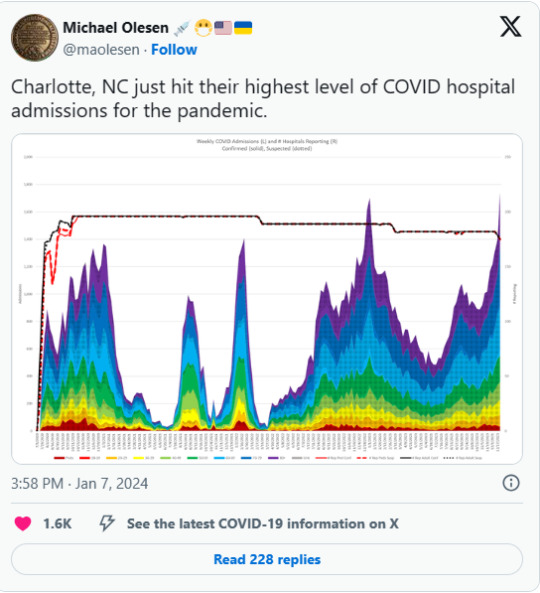
Dr. Joseph Khabbaza, a pulmonary and critical care specialist at the Cleveland Clinic, told the Today Show website: “The current strain right now seems to be packing a meaner punch than the prior strains. Some features of the current circulating strain probably (make it) a little bit more virulent and pathogenic, making people sicker than prior (variants).”
Indeed, two recent studies indicate that JN.1 more efficiently infects cells in the lower lung, a trait that existed in pre-Omicron strains which were considered more deadly. One study from researchers in Germany and France noted that BA.2.86, the variant nicknamed “Pirola” from which JN.1 evolved, “has regained a trait characteristic of early SARS-CoV-2 lineages: robust lung cell entry. The variant might constitute an elevated health threat as compared to previous Omicron sublineages.”https://www.youtube-nocookie.com/embed/1MGIQxPf0Ig?rel=0An appeal from David North: Donate to the WSWS todayWatch the video message from WSWS International Editorial Board Chairman David North.DONATE TODAY
The toll on human life from the ongoing wave of mass infection is enormous. It is estimated that one-third of the American population, or over 100 million human beings, will contract COVID-19 during just the current wave. This will likely result in tens of thousands of deaths, many of which will not be properly logged due to the dismantling of COVID-19 testing and data reporting systems in the US. When The Economist last updated its tracker of excess deaths on November 18—before the JN.1 wave began—the cumulative death toll stood at 27.4 million, and nearly 5,000 people were continuing to die each day worldwide.
The current wave will also induce further mass suffering from Long COVID, which has been well known since 2020 to cause a multitude of lingering and often debilitating effects. Just last week, a pre-print study was published in Nature Portfolio showing that COVID-19 infection can cause brain damage akin to aging 20 years. The consequences are mental deficits that induce depression, reduced ability to handle intense emotions, lowered attention span, and impaired ability to retain information.
Other research indicates that the virus can attack the heart, the immune system, digestion and essentially every other critical bodily function. The initial symptoms of COVID-19 might resemble those of the flu, but the reality is that the virus can affect nearly every organ in the body and can do so for years after the initial infection. While vaccination slightly reduces the risks of Long COVID, the full impact of the virus will be felt for generations.
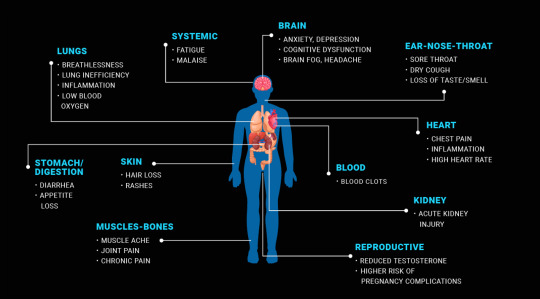
The latest winter wave of infections and hospitalizations takes place just eight months after the World Health Organization (WHO) and the Biden administration ended their COVID-19 public health emergency (PHE) declarations without any scientific justification. This initiated the wholesale scrapping of all official response to the pandemic, giving the virus free rein to infect the entire global population ad infinitum.
A virtual blackout of any mention of the coronavirus in the corporate media accompanied the swan song of official reporting. From then on, if illnesses at hospitals or among public figures were referenced at all, it was always with the euphemism “respiratory illness.” The words COVID, coronavirus and pandemic have been all but blacklisted, and the facts about the dangers of the disease have been actively suppressed.
Summarizing the cumulative results of this global assault on public health, the WSWS International Editorial Board wrote in its New Year 2024 statement:
All facts and data surrounding the present state of the pandemic are concealed from the global population, which has instead been subjected to unending lies, gaslighting and propaganda, now shrouded in a veil of silence. There is a systematic cover-up of the real gravity of the crisis, enforced by the government, the corporations, the media and the trade union bureaucracies. Official policy has devolved into simply ignoring, denying and falsifying the reality of the pandemic, no matter what the consequences, as millions are sickened and thousands die globally every day.
In response to the latest wastewater data, there have only been a handful of news articles, most of which have sought to downplay the severity of the current wave and largely ignored the deepening crisis in hospitals.
The official blackout has given rise to an extraordinary contradiction in social life. The reality of mass infection means that everyone knows a friend, neighbor, family member or coworker who is currently or was recently sick, or even hospitalized or killed, by COVID-19. Yet the unrelenting pressure to dismiss the danger of the pandemic means that shopping centers, supermarkets, workplaces and even doctor’s offices and hospitals are full of people not taking the basic and simple precaution of masking to protect themselves. Every visit outside one’s home carries the risk of being infected, with unknown long-term consequences.
As the pandemic enters its fifth year, it is critical to draw the lessons of this world historical experience. The past four years have demonstrated unequivocally that capitalist governments are both unwilling and incapable of fighting this disease. Their primary concern has always been to ensure the unabated accumulation of profits by corporations, no matter the cost in human lives and health.
The real solution to the coronavirus is not to ignore it, but to develop a campaign of elimination and eradication of the virus worldwide. To do so requires the implementation of mask mandates, mass testing and contact tracing, as well as the installation of updated ventilation systems and the safe deployment of Far-UVC technology to halt the spread of the virus. The resources for this global public health program must be expropriated from the banks and financial institutions, which are responsible for the mass suffering wrought by the pandemic.
All of these measures cut directly across the profit motive and the real disease of society: capitalism. As such, the struggle against the coronavirus is not primarily medical or scientific, but political and social. The international working class must be educated on the real dangers of the pandemic and mobilized to simultaneously stop the spread of the disease and put an end to the underlying social order that propagates mass death. This must be developed as a revolutionary struggle to establish world socialism.
7 notes
·
View notes
Text
The Weather
The CDC ended their national US COVID community-level transmission map in May. We created this map to document 7-day cumulative COVID rates based on laboratory-confirmed COVID cases in states that are still tracking and reporting. Obviously, this map cannot be relied upon to give accurate information about transmission risk because only a fraction of COVID cases are actually counted. Still, it provides us a visual reminder that the COVID pandemic is not over. You can read more about our map and methods here.
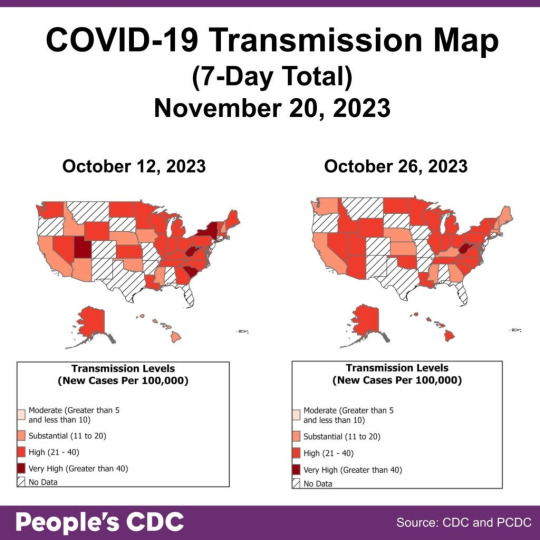
Wastewater
The wastewater monitoring landscape is in flux! We remind you that you should find the most local source of wastewater for you, and use that as your best source of pandemic monitoring. You might find your city or one nearby on Biobot’s website. Scroll to the bottom and click the “SHOW ALL” button.
You can also check out WastewaterSCAN. You will see two boxes next to the words “Local Data Near.” Put your zip code in one, and select the Sars-CoV-2 for the second box. Then, you’ll see the company’s assessment of your risk level.
The image below is the resulting risk level for 48081, a zip code in Macomb County, Michigan.
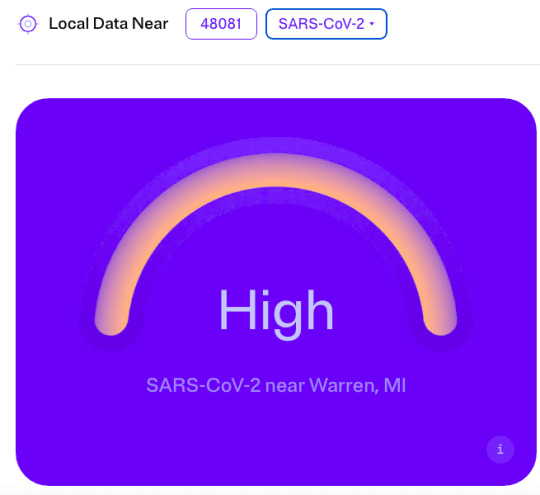
If you’re wanting a graph to compare current wastewater levels to previous periods of time, click “DASHBOARD” on the upper right hand corner of the site. A US map will come up with a search bar at the top of it. Put your zip code into the map or scroll into the nearest wastewater site manually. When you click on the purple dot representing your nearest monitoring site, you’ll see a panel on the left titled “Overview for [CITY, STATE].” On the upper right hand side of that panel, there is a purple arrow. Click it. Then you can see trends. “Last 3 months” is the default period of time, but you can change the period of time you’re looking at by clicking the down arrow and selecting a different range.
The image below shows a local graph for the wastewater site nearest that same Michigan zip code.

Below is the graph for national wastewater data. Your local data will likely differ from national trends, so it is best to look up the wastewater site nearest you.

Wins
We are heartened to see masks at protests throughout the country. Whether it’s #StopCopCity actions to oppose further militarization of police in this country or marches, die-ins, and disruptions to oppose occupation and genocide in Palestine, people see that we can demand and create another world together, and that we can keep each other safe while we do it.
Long COVID
A recent study has been published that is relevant for those considering taking nirmatrelvir (Paxlovid) or molnupiravir (Lagevrio) to reduce the risk of Long COVID. This study of Medicare enrollees, published in JAMA Internal Medicine, found that nirmatrelvir and molnupiravir were associated with a small reduction in the incidence of Long COVID.
On repeat infections, Nature Communications published a cohort study done in Spain and the UK comparing COVID cases, reinfections, and negative-test controls which demonstrated that reinfections had a higher risk of Long COVID. This is a big deal– it builds on the growing literature demonstrating the dangers of repeat infections, pointing again to the importance of taking this pandemic seriously and avoiding infection, as many times as we can.
Take Action
Sign NNU’s letter urging the CDC “to reject HICPAC’s weak draft and create a new one that protects health care workers and their patients!”
And check out this piece published in JAMA this week arguing that physicians, hospital administrators, and regulators have an ethical obligation to protect patients through masking.
Safer Gatherings
It’s that time of year again! Please ensure your holiday gatherings are as safe as possible by implementing as many layers of protection as you can!
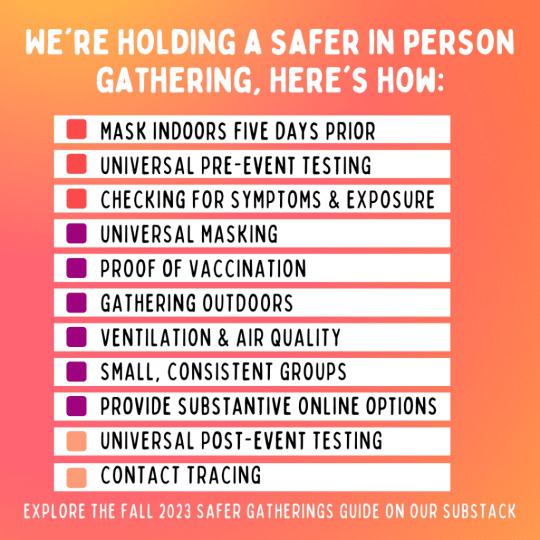
On that note, we will not be publishing a Weather Report next week, because our team will be dedicating our time to revamping our current Safer Gathering Toolkit instead! We look forward to sharing with you soon!
#op#img#described in alt text#covid#covid pandemic#covid news#covid 19#covid19#covid-19#coronavirus#pandemic#sars cov 2#sars-cov-2#long covid#pcdc#people's cdc#medical#medical news#coronavirus pandemic
9 notes
·
View notes
Video
youtube
COVID rapidly spreads in China as government eases strict quarantine rules, December 27, 2022
China is grappling with the rapid spread of COVID-19 after the government began rolling back its zero-COVID restrictions earlier this month. Now, cases are spiraling across towns and cities, hospitals are overburdened, medical staff are outnumbered and crematoriums are running out of space. Judy Woodruff reports.
PBS NewsHour
There is no nuance left in politics or public health policy when there is either an absolute and strict inflexibility of zero COVID or wholesale dismantling of safeguards before the healthcare or support systems are prepared for the waves that have been forcibly suppressed. The political insistence on using their own less effective, non-mRNA vaccines based on the original strains rather than Delta or Omicron, coupled with a low vaccination rate of the vulnerable and elderly is not helping easing the transition at all.
The way they’ve been counting mortality from COVID diverged from nearly every other country since early 2020. A death had to be directly attributable to SARS-CoV-2 eliminating cases of many preexisting or undiagnosed conditions, chronic illnesses, and other high risk factors that may have been exacerbated by the virus which became listed as the direct cause or if they simply tested negative in the few days before dying. The policy as of this week will further limit the count only to deaths caused by pneumonia or respiratory failure after contracting COVID, in addition to dropping much of the remaining inbound quarantines and regular case counts becoming even more inconsistent with lived reality.
It appears the PRC was prepared to stay in suspended animation within an onionskin of self-isolation layers indefinitely, maintaining the appearance of control and adherence to policy that was left to different local officials to execute. Downgrading the classification removes the local, emergency-style powers to lockdown and quarantine which were used capriciously. Residential buildings, offices and commercial areas such as malls, and even theme parks could be suddenly cordoned without warning, causing panic due to the stringency of testing and knock-on effects if a positive case was found rather than fear of having contacted or contracted the virus. Becoming listed as a close contact or a complete stranger’s positive result could mean further quarantining and repeated testing, as well any change in one’s COVID passport status severely restricting mobility for work or education, travel, or even basic necessities. The protests spread because “dynamic zero” was anything but dynamic, refusing to change or amend course in preparation for a transition to an endemic or post-epidemic state. People were simply fed up and the building momentum was becoming a potential danger to a regime that had just renewed its own political mandates.
These things aren’t happening in isolation, China is also changing tact on its travel restrictions domestically and internationally. The Special Administrative Regions of Hong Kong and Macau have been trying to reopen ports and travel with the Mainland for years now for travel and economic reasons. Both were forced into accepting one-way policies where it was difficult for their citizens to enter China or even between one another, while rules were softened for travelers and politicians entering from and returning to the Mainland for short trips with the reason that the pandemic was less well-contained than within the Mainland.
As news of the highly visible current outbreak within China is continuing to emerge, the Hong Kong SAR is now proudly announcing agreements have been made with the Mainland to drop their travel restrictions posthaste. It’s being reported that many are travelling specifically for mRNA vaccines which are approved in Macau and Hong Kong.
#China#covid 19#coronavirus#pandemic#public health#politics#Chinese Communist Party#Xi Jinping#pbs newshour#seriously#fundamentally ridiculous#bureaucracy#zero covid policy#vaccination#epidemiology#reuters#financial times#news#current events#health care
43 notes
·
View notes
Text
Linear Progress
I want to take a minute to reflect on what my path through academia has been, where I am now, and where I want to go.
I got good grades in high school, did my extracurriculars, scraped through to graduation despite missing a lot of school due to ED/depression.
I got accepted to a really prestigious college, which I had to drop out of before the end of my first semester due to ED/mental health issues.
Still believed I wanted to go to college, applied to colleges closer to home where my support network was. Screwed up my application and wasn't considered anywhere.
Took a single class at a nearby university to prove to myself I was still capable of learning.
Went to a nearby college half-time that happened to have a really strong program for my major. Fell in love with the college, applied, and got in.
I had a great time in undergrad! Worked to support myself, got all As, studied abroad but got sent home during COVID, graduated with a 100-page honors thesis under my belt.
Took a year off to take the GRE and apply to PhD programs. 9 total. Did great on the GRE because I'm a good test taker.
Rejected everywhere I applied. Managed to talk to the department of one university and finagled myself into their master's program for the coming fall.
Finished my master's in 3 semesters with a 4.0 while working to pay for school and rent, in a city where rent alone was over 60% of my income.
I could have applied for a PhD at that school during my first semester, but my adviser told me to hold off a year and use that extra experience to qualify myself for more prestigious PhD programs, since I want to be a professor.
I followed the advice, finished my master's, applied to PhD programs again. 7 total.
Rejected everywhere. Wait listed at my masters institution and waiting to hear back. Looking for research positions in the meantime so I can boost my resume and get myself out of the soul-crushing job I'm working now.
I still want to keep trying to get into a PhD program. All I want to do is spend my life researching and teaching what I am passionate about, within a community of like-minded people.
I'm still sitting with the grief of not having my next 5 years secured via a PhD program admission - not knowing where I'll live, where my health insurance will come from, where my paychecks will come from, or how I can improve my candidacy from here.
None of this can go in a PhD application essay. They don't care if my therapist told me I can persevere. I feel like it should matter at least a little bit, though.
2 notes
·
View notes
Text
Gov. J.B. Pritzker on Wednesday signed a law providing full disability benefits to Chicago police officers and firefighters struck by COVID-19 before vaccines were available, presiding over an emotional statehouse ceremony which marked the end of a financial struggle for responders including the brother of Comptroller Susana Mendoza.
The Act-of-Duty Law, HB3162, ensures disability benefits of 75% of salary plus health insurance for anyone unable to work after contracting the coronavirus from March 9, 2020, when the flare-up intensified in Illinois, until June 30, 2021. The law grants them the presumption that they picked up the illness on the job.
Pritzker said after COVID-19′s arrival in early 2020, police, fire and medical personnel were both a line of defense and a lifeline.
“Our first responders were key to our national response, transporting infected patients to hospitals, disbursing masks and testing kits or providing care to those in distress…,” Pritzker said. “But even with social distancing, masks and mitigations in place, many of our first responders became infected with COVID-19.”
Mendoza’s brother, 58-year-old police Det. Joaquin Mendoza, was a veteran officer who worked the midnight shift. With no spouse or children, the comptroller said work was his only focus. In November 2020, when the city canceled days off, he worked 17 straight days, woke up one morning with a cough and two days later was rushed to the hospital with COVID-19.
He moved in with his sister and her family and since then, he’s had five strokes and lost both kidneys, requiring thrice-weekly dialysis. But the Policeman’s Annuity and Benefit Fund of Chicago denied his claim for full disability because there was no proof that he contracted the virus on the job. The board also denied Officer Diana Cordova-Nestad.
“This has been the most hellacious experience…,” Mendoza said. “I don’t want any police officers to feel that their only recourse is to recognize that they’re worth more dead than alive and decide to eat a bullet because they don’t want to deal with this. … I know it sounds dramatic, but it’s real.”
Mendoza said she know of about 20 others who will benefit from the law — after her brother and Cordova-Nestad were denied, no one else sought benefits.
“It’s a small universe… so you’re not talking about opening up the floodgates,” she said.
Joaquin Mendoza had planned to attend the bill signing but underwent surgery again on Tuesday and remains hospitalized.
“He told me that maybe it had to happen… because he’s the only one with a sister who knows how to navigate this crazy system and can right the wrong for brothers and sisters on the force,” the Comptroller said.
#us politics#news#illinois#gov. j.b. pritzker#Act-of-Duty Law#HB3162#disability benefits#Susana Mendoza#COVID-19#coronavirus#coronavirus pandemic#Det. Joaquin Mendoza#Policeman’s Annuity and Benefit Fund of Chicago#Officer Diana Cordova-Nestad#2023
15 notes
·
View notes
Text
Covid-19 cases on the rise in Sao Paulo and in the region

Authorities in the city of São Paulo have reported that the number of Covid-19 cases more than tripled between the first epidemiological week of 2024 (Dec. 31, 2023, to Jan. 6, 2024) and the sixth (Feb. 4 to 10) after growing from 881 detections to 3,443, according to the interactive panel of the Municipal Health Department (SMS).
David Uip, national director of infectiology at Rede D'Or, said there should be even more cases since “most tests are done at home and are not reported to the government.” Hence, “the figures given by the health authorities tend to be lower than the reality,” he went on.
Infectiologist Emy Gouveia of São Paulo's Albert Einstein Hospital said the increase in Covid-19 cases in recent weeks was associated with the circulation of a new variant in the country. “The JN.1 variant of the omicron arrived in Brazil at the end of 2023, and whenever there is the arrival of a new variant, there is the possibility of an increase in cases.”
The scenario is likely to worsen throughout Brazil with the Carnival celebrations, according to infectiologist Renato Grinbaum of the Brazilian Society of Infectious Diseases (SBI). “The Covid-19 virus is transmitted through exposure to contaminated respiratory fluids, which is favored by the crowds typical of this period.” But “unlike during the pandemic, today a large part of the population has already had contact with the virus and is vaccinated - and therefore better protected,” he stressed.
Continue reading.
#brazil#brazilian politics#politics#coronavirus#covid 19#mod nise da silveira#image description in alt
3 notes
·
View notes